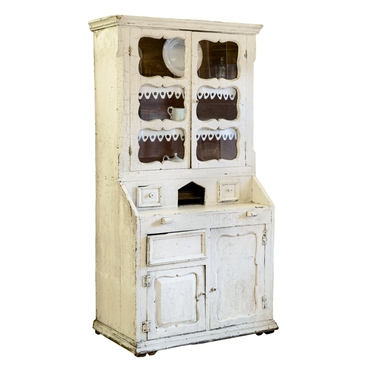The term “botalo” (cowbell) was used to denote a special metal rattle or a bell that was worn around the neck of cows, goats, and other livestock. Craftsmen made such items of scrap materials. The outer part of botalo was usually bent of copper or iron sheet. Any metal item (a piece of iron, a heavy screw, or a gear wheel) could be used as a jinglet to produce sounds. Sometimes, botalo bells were made of wood. But those did not jingle so loudly.
In contrast to usual bells, melody was out of significant importance for botalo bells. Conversely, it was believed that its sound should be loud, harsh and even unpleasant to scare away wolves and bears when cattle grazed not far from the forest. Moreover, thanks to its clinking the owners could differ their animals from others and find the lost cows.
Botalo from the collection of Nizhnevartovsk Museum of Local History is made of a metal sheet rolled in a trapezoidal shape. A large gear ring serves as its jinglet. At the upper part of the bell, there is a bow, which was used to attach a rope that was tied around the animal’s neck.
These bells were usually large and heavy. That iswhy they did not always suit small animals, such as goats, sheep, calves, or foals. Botalo bells were replaced with metal bells for them. They were also handmade: the ends of an iron or copper sheet were rolled in such a way as to form a hollow inside the ball. Several pieces of wood or iron were placed in it. The sound of such a bell was dull. That is why it was called “glukhar” (consonant with Russian “dull”).
The peasants were sure that bells for cattle were magical. Many of them believed that the sound of a bell could drive away evil spirits, such as vodyanoy (a mean spirit of lakes and rivers), leshiy (a mean spirit in the woods), kikimora (a mean spirit of the swamp). It was thought that thanks to bells, the animals would not get lost and drown in the swamp.
The term “botalo” had a figurative sense. People, who lived in the Sverdlovsk Governorate, used it to name a changeable and frivolous man, a chatterbox, or a fabler. The residents of the banks of the Yenisei river used the word “botalo” for ones whose shoes soles knocked loudly. And dwellers who lived near Arkhangelsk used it for drunks. They used to say, “staggering like a botalo”.
In contrast to usual bells, melody was out of significant importance for botalo bells. Conversely, it was believed that its sound should be loud, harsh and even unpleasant to scare away wolves and bears when cattle grazed not far from the forest. Moreover, thanks to its clinking the owners could differ their animals from others and find the lost cows.
Botalo from the collection of Nizhnevartovsk Museum of Local History is made of a metal sheet rolled in a trapezoidal shape. A large gear ring serves as its jinglet. At the upper part of the bell, there is a bow, which was used to attach a rope that was tied around the animal’s neck.
These bells were usually large and heavy. That iswhy they did not always suit small animals, such as goats, sheep, calves, or foals. Botalo bells were replaced with metal bells for them. They were also handmade: the ends of an iron or copper sheet were rolled in such a way as to form a hollow inside the ball. Several pieces of wood or iron were placed in it. The sound of such a bell was dull. That is why it was called “glukhar” (consonant with Russian “dull”).
The peasants were sure that bells for cattle were magical. Many of them believed that the sound of a bell could drive away evil spirits, such as vodyanoy (a mean spirit of lakes and rivers), leshiy (a mean spirit in the woods), kikimora (a mean spirit of the swamp). It was thought that thanks to bells, the animals would not get lost and drown in the swamp.
The term “botalo” had a figurative sense. People, who lived in the Sverdlovsk Governorate, used it to name a changeable and frivolous man, a chatterbox, or a fabler. The residents of the banks of the Yenisei river used the word “botalo” for ones whose shoes soles knocked loudly. And dwellers who lived near Arkhangelsk used it for drunks. They used to say, “staggering like a botalo”.


